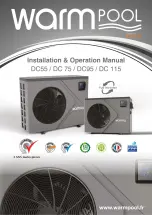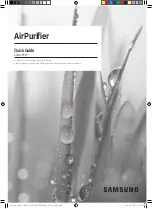
CyberAiR DX Floor Mounted IOM Manual
Utility Connections and refer to the wiring
diagram supplied with your unit.
6. Seal the hole in the wall behind the sensor.
7. Replace the cover plate on the base.
CAUTION
The sensor can be damaged if handled
improperly. Take care not to damage the
exposed temperature/humidity sensor on the
PC board. Do not touch the sensor as this will
affect its accuracy.
2.6.5
Remote Water Detector
The remote water detector is normally placed on
the sub-floor or in a field supplied auxiliary drain
pan located beneath the unit. STULZ provides 2
types of water detectors:
Spot type water detector
-
Remove the protective cover and connect two control
wires to the terminals on the
base. Run the control wires into
the electric box and connect
them to the control terminal
block
as shown in the wiring diagram
provided with your unit.
Replace the cover and place
the water detector(s) on the
floor with the
metal electrodes facing down. When water is
present, current will flow between the electrodes.
The base is provided with a mounting hole in the
center which may be used to secure the water
detector in place.
NOTE
Do not place the spot type water detector
on an electrically conductive surface.
Cable type water detector
-
Lay the cable water detector flat across the sub-floor
where water could collect
(see Figure 9). Secure
the cable every 12-18
inches with J-clips or
cable ties with adhesive
mounting
pads when installing it in the airstream. When
routing it around obstructions, secure it at each turn
of the cable. Do not tie the water detector cable to
the metal floor stand or to metal pipes.
When a water leak on the floor reaches the cable,
current will flow between the cable wires. A two
conductor wire harness is provided with a quick
connect fitting on the end. The harness mates to the
fitting on the water detector and connects it to the
2-9
control terminal block inside the electric box (see Figure
16) as shown in the wiring diagram provided with
your unit.
2.7 Piping Connections
Field piping connections for the system (refrigerant,
water, water/glycol and optional hot water reheat
piping) are sweat connections. CFD (downflow) units
typically have pilot holes available for the routing
piping and wiring through the floor of the cabinet. The
piping connections are inside the cabinet. The
STULZ installation drawing (furnished with your unit)
shows the recommended entry location.
CFU (upflow) units are typically provided with pipe
connections stubbed out at the top of the cabinet.
When considering how to route the piping and wiring
for CFU units furnished without top piping, entry
holes may be drilled through either the floor of the
cabinet or through a side panel. For special piping
requirements contact STULZ for technical
assistance.
If piping is brought into the side of the cabinet, ensure
adequate working space is available on that side or if
necessary cut a service opening into the adjacent
wall if the unit is installed in a corner.
The piping should be isolated by the use of vibration
isolating supports. Provide supports (clamps or
hangers) as necessary every 5 to 10 feet along piping
runs to minimize vibration and noise transmission. To
reduce vibration transmission and prevent pipe
damage, seal openings in walls using a soft flexible
material to pack around the piping. After the piping is
installed, seal the gaps between the pipes and the
cabinet entrance holes so air won’t leak around the
pipes.
For pipe connection sizes, see the installation
drawing provided with your unit. Field piping is not
necessarily the same size as the unit’s pipe
connections.
2.7.1
Refrigerant Piping
2.7.1.1 Self-Contained Systems
No refrigeration connections are required for
self- contained water or water/glycol cooled
systems.
2.7.1.2 Split Systems
Split air-cooled systems with a remote condenser will
require field installed refrigeration piping. All split systems
are shipped with a dry nitrogen holding charge of 100
psig. Release the pressure via an available stem valve or
Schrader valve prior to uncapping the pipes.
Do not release the pressure until the field
installed refrigerant piping is ready to connect.
















































